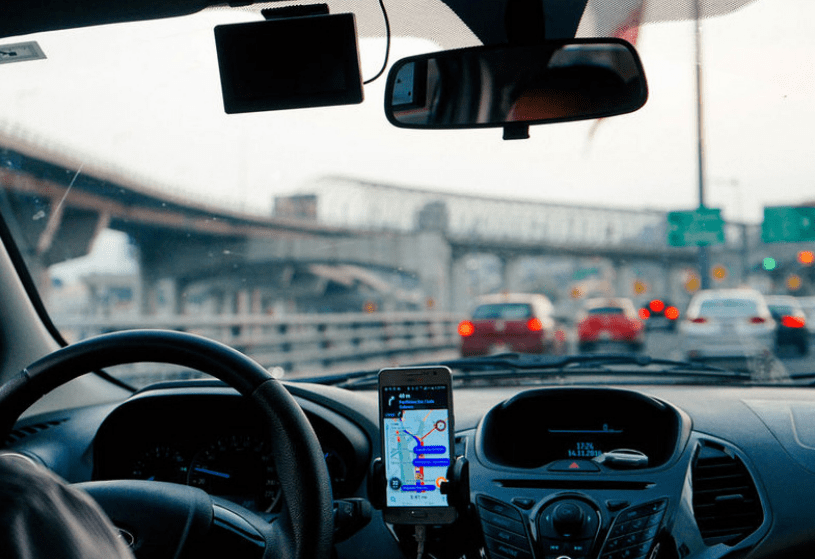Companies like Uber have turned driving a vehicle for hire into a desperate struggle to make ends meet, clogging city streets with cars in the process. Now a report commissioned by the NYC Taxi and Limousine Commission is charting a way to advance on both wages and traffic.
Uber’s business model rests not just on flooding streets with cars but on maximizing drivers’ idle time so that passengers can more quickly summon rides. The report, covered by the New York Times and Crain’s NY Business last week, aims to raise wages for drivers at Uber and the other app-based ride services in part by reducing idle time. The effect won't be strong enough to un-jam New York's streets, but it could prevent the ride-hail companies from making congestion worse.
Authors James A. Parrott and Michael Reich are veteran economists with long careers advocating for pro-labor policies. Their key recommendation is that the city adopt a per-minute and per-hour earnings formula for app-based drivers. Under this formula, drivers’ compensation for each fare would rise automatically in proportion to the percentage of time in which each company’s drivers had zero passengers in their vehicle in the prior three months.
The policy would incentivize Uber, Lyft, Via, and Gett/Juno -- the four companies that dominate the sector -- to deploy their dispatch algorithms to maximize the time drivers are on duty with a fare in the car, known as the "driver utilization rate." That in turn would diminish “cruising” time that squeezes drivers and adds to congestion, resulting in a win for both workers and traffic.
The Parrott-Reich report does not directly address congestion, nor does it cover medallion taxis. But its implications are enormous. Annual revenue from app-based ride services is now $3 billion a year -- $2 billion for Uber alone. According to the authors, the four companies together dispatched nearly 600,000 rides per day in the five boroughs in the first quarter of 2018 -- twice as many as in 2016 and double the volume for medallion cabs. Although a slight majority of the companies’ rides occur outside the Manhattan "taxi zone," including in areas underserved by both medallion taxis and transit, drivers’ propensity to wait in the zone to be pinged has contributed to steadily worsening traffic conditions in the Manhattan Central Business District.
Parrott and Reich's proposed “pay standard” would raise average driver pay after expenses by 22.5 percent, to $17.22 an hour -- which for independent contractors equates to a $15/hour minimum wage, according to the authors. The 85 percent of app-based drivers whose pay currently falls below the $17.22/hour standard would take home an additional $6,345 per year, on average. With an estimated 80,000 workers now driving in New York City, largely full-time, for the four companies, the aggregate increase in wages would be on the order of half a billion dollars a year -- providing a measurable boost to the city’s economy.
The extra earnings would come from three sources: higher utilization rates, smaller commissions, and higher fares. The report posits a range of scenarios, with a typical outcome entailing a utilization increase from 58 percent to 62 percent, a halving of the 16.6 percent industry-average commission rate, and a 3 percent rise in fares. Passenger wait times would lengthen, since fewer vehicles would be “goal-hanging” or cruising for fares, but only by around 15 seconds per trip.
While ordinarily any proposal trimming commission rates by 50 percent for the likes of Uber and Lyft would be DOA, the Parrott-Reich plan might yet see the light of day. The financial desperation of tens of thousands of for-hire drivers has led to a rash of suicides and can’t be ignored. And while the proposal won’t by itself cure Manhattan traffic gridlock -- in fact, it may only keep it from worsening, by leading the companies to suppress hiring growth -- it could take Uber and Lyft off the hook for worsening congestion.
Also in the proposal’s favor is the quality of the report. The 89-page volume is extensively researched, and the authors’ progressive credentials are impeccable. Although the NY Taxi Workers Alliance has derided its recommendations as “piecemeal policy that leaves drivers in poverty,” the alliance’s labor allies may embrace what the authors are calling "the first pay standard in the U.S. to apply to independent contractors." Council Member Brad Lander has already written Intro 890-2018, a bill to implement the Parrott-Reich policy. For its part, Uber has thus far criticized the report only in vague and relatively mild terms, though the company is ramping up an ad campaign to fend off regulation.
Mayor de Blasio should seize the recommendations and run with them. Parrott and Reich, and the mayor’s own Taxi & Limousine Commission, which guided their work, are offering up a smart and powerful mechanism to move away from cowboy capitalism and toward more equitable and rational governance of the city’s streets.






